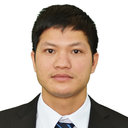
Ba Dinh BuiHanoi University of Science and Technology · Mechatronics
Ba Dinh Bui
PhD of Engineering
About
7
Publications
23,667
Reads
How we measure 'reads'
A 'read' is counted each time someone views a publication summary (such as the title, abstract, and list of authors), clicks on a figure, or views or downloads the full-text. Learn more
98
Citations
Introduction
Research about precise controller in Machine tool and new machine tool dynamics analysis method. System identification - A frequency domain approach.
Research Interest:
o Safety assessment Human-Robot collaboration
o Autonomous Vehicles/Robots
o Stair Climbing Wheelchair
o Nonlinear, robust, and adaptive control
system design
o Nonlinear friction model-based control
o Machine tool controller design
https://buidinhba5.wordpress.com/about/
Additional affiliations
April 2018 - present
National Institute of Advanced Industrial Science and Technology (AIST)
Position
- PostDoc Position
Description
- I am currently a Postdoctoral Research Fellow in JRL-Joint Robotic Laboratory, Intelligent Systems Research Institute, National Institute of Advanced Industrial Science and Technology (AIST) where I am working on motion planning for humanoid robot HRP2.
April 2017 - February 2018
Education
April 2014 - March 2017
April 2012 - March 2014
Publications
Publications (7)
In feed drive systems, particularly machine tools, a contour error is more significant than the individual axial tracking errors from the view point of enhancing precision in manufacturing and production systems. The contour error must be within the permissible tolerance of given products. In machining complex or sharp-corner products, large contou...
Generation of motion trajectories is a crucial task in feed drive control for efficient manufacturing and energy saving. They have to be smooth enough to be traversable without violating systems constraints. Literary, a number of methods, such as spline parametric trajectories have been suggested for smooth trajectories generation. However, there a...
This paper proposes an adaptive nonlinear sliding mode control for feed drive systems. The aim is to increase precision by minimizing tracking errors of each feed drive axis without additional energy consumption. The proposed adaptive sliding mode control law is used to adjust controller gains based on the tracking error at each sampling time. Ther...
Friction is the main disturbance in mechanical systems especially in computerized numerical control machine tools with high precision, speed, and performance requirements. Much recent research have proven that a controller with friction compensation provides better performance. Some classical friction models such as the Coulomb-viscous-Stribeck fri...
Friction exists in mechanical systems, such as machine-tool feed drives, and causes undesired position tracking errors. The most difficult problem in friction compensation is nonlinear friction during changes in motion direction or in low velocity regions causing significant tracking errors. Many static and dynamic friction models have been propose...
Friction is a primary disturbance in mechanical motion control of high precision machines. Because the friction causes undesired effects such as steady state and tracking motion errors of industrial machines, control systems should be designed to compensate for frictional effects. In this paper, we propose a simple yet really efficient method for e...
Questions
Question (1)
Assumed We have a motor and control plant with Inertia and viscous friction.
G(s) = K/(J.s2+B.s). Use P controller with gain Kp we have closed loop
control: Y(s)/X(s) = Kp.k/(j.s2+B.s+Kp.K). Where X(s),Y(s) reference
input and real output motor angle respectively. If we increase gain Kp, system will have fast response (X=Y).The question is why the controller gain Kp can not increase to infinite ?. Explain use Bode plot with gain and phase magrin criteria.
I search in Internet and know that Kp is limited for Gain magrin > 0. But in this case there is no cross over at 180degree in phase plot Bode of open loop. How can we prove system wil be unstable when Kp go to infinite.

















